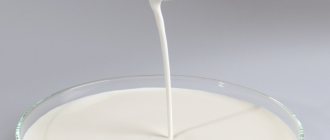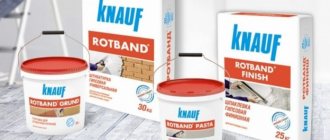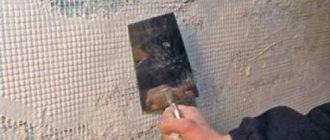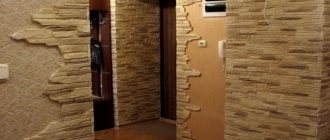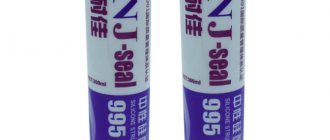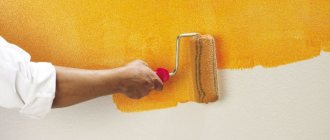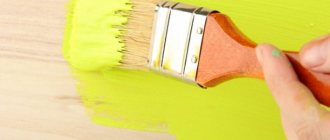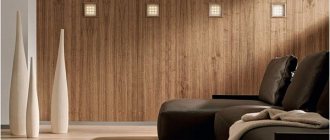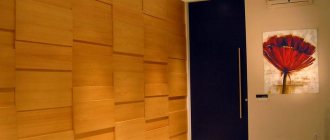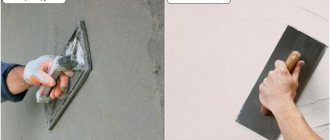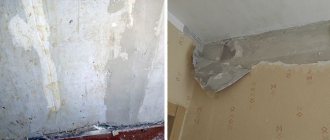In order for the cladding to last longer and look beautiful, it is necessary to carefully prepare the surface. In addition to eliminating various defects, it is recommended to use gypsum putty. This will make the coating smooth and suitable for further decoration. You should find out in more detail why gypsum putty is needed and what features it has.
Types, composition and characteristics
The putty has a gypsum base, which can be white or yellowish. In addition to gypsum, various polymers, modifiers and mineral additives are added to the composition. Finely ground marble flour and quartz sand are usually used as the latter.
Gypsum putty is divided into several types, including:
- Starting. It is distinguished by coarse grinding, graininess and a loose structure in appearance. Allows you to fill all roughness and defects. If the surface is fairly flat, then plaster treatment is not required before applying the starting look. Suitable for wallpapering.
- Finish. The mixture is finely ground, making it look homogeneous and plastic. Used at the last stage before finishing the surface with the base material. Allows you to achieve perfect evenness. It is not intended to get rid of complex defects, but to smooth the surface, making it smooth. Suitable for coloring.
- Universal gypsum putty. It combines the two previous types. It is recommended to apply it in a thin or medium layer to avoid cracking. Suitable for relatively smooth surfaces without serious defects.
It is recommended to apply it in a thin or medium layer to avoid cracking.
It is also worth noting the technical characteristics of the material:
- The mass can be applied at temperatures from +5 to +30 degrees;
- The layer thickness should not be more than 5 mm;
- The mixture sets in an hour;
- The putty dries within 3 hours;
- Gains strength for a week.
Before purchasing or using putty, be sure to study the information on the packaging and check the expiration date of the product.
The layer thickness should not be more than 5 mm.
Storage rules
The shelf life of gypsum putties is 6–12 months . Subsequently, the mixture cakes, the particles stick together and the composition loses its plasticity. You need to leave it in a dark, cool and always dry place. This applies to undamaged original packaging. Once opened, the shelf life is reduced by 2–3 times.
Valera
The voice of the construction guru
Ask a Question
Use expired putty carefully. Having lost its plasticity, such a mixture acquires greater viscosity and is laid in a thicker layer. These features can be used at work. You can plant socket boxes on this putty, seal its grooves and baguettes. For finishing you need a fresh mixture.
Scope of application
Putty is designed to level the surface before the main finishing. It has good properties, making it suitable for various materials. It can be used to seal seams on walls and ceilings, fill cracks of varying thickness and depth, and eliminate various defects and errors. The putty is also suitable for high-quality filling of joints formed between sheets of drywall.
It is better not to putty on materials such as brick, stone or chipboard. The mixture is not suitable for them.
The standard mass is not recommended for use in the kitchen, bathroom and rooms with high humidity levels. Water will quickly be absorbed into the surface, and the putty will lose its strength. Therefore, for such conditions it is worth choosing a mixture with increased moisture resistance.
Putty is designed to level the surface before the main finishing.
About the manufacturers
It is necessary to trust large companies to decorate your own walls. For example, the best putty manufacturers are:
- Knauf is a company from Germany. It has factories in many countries and in Russia. The products are high quality and affordable for most people;
- Ceresit is a large manufacturer of polymer and cement types;
- Tikkuriia is a concern specializing in many types of products, including gypsum and acrylic compounds.
Popular brands
Popular Russian manufacturers include the “Starateli” brand. It allows you to putty various surfaces and is one of the leaders in the domestic market. If it is necessary to treat a surface on which plaster has already been applied, it is recommended to choose “Hercules”. Suitable not only for flat surfaces, but also for processing joints. For the final stage of preparation before the main cladding, Bolars is also suitable. Also, “Unis”, which is characterized by high ductility, is often used for the finishing coating.
Putty “Starateli” allows you to putty various surfaces and is one of the leaders in the domestic market.
Preparation
Instructions on how to dilute and use gypsum putty are displayed on the packaging - on a paper bag or plastic bucket. You should start your work with it, do everything point by point as it is written.
We will need the following tools to prepare the solution:
- Capacity;
- Warm water;
- Mixer or drill with a screw attachment.
It is important to bring the solution to a homogeneous paste-like state. Let it sit and let the plaster dissolve well.
Application technology
In order for the surface preparation work before the main cladding to be high-quality and durable, it is necessary to follow the technology for applying the mixture. First, it is recommended to process the rough version, then cover the entire area with the selected type of putty, and only after that can you continue with the repair.
In order for the surface preparation work before the main cladding to be high-quality and durable, it is necessary to follow the technology for applying the mixture.
Preparing the mixture
First you need to properly prepare the mixture. Putty can be sold dry or ready-made. In the first case, the product is in bags that differ in volume. If you have to process a large area, then it is better to choose the dry version, it is more convenient in this case. To dilute the mass, you need to mix water and dry powder, carefully observing the proportions indicated on the putty packaging. It is recommended to use a construction mixer for thorough mixing.
The finished look is completely ready for use. The mass is in a bucket, and nothing needs to be mixed. The main thing is to stir the mixture before use so that the structure is more uniform.
It is recommended to use a construction mixer for thorough mixing.
Preparing surfaces for puttying
This stage includes mandatory cleaning of the surface from dust and dirt. You should also degrease the working area and prime it. If there is a high level of humidity in the room, then the surface is additionally treated with an antifungal compound.
The working area should be degreased and primed.
Starting and finishing putty
It is recommended to apply the starting type of mixture using several spatulas. The small ones scoop the required amount of mass from the container and apply it to the large instrument. And then the surface is treated with a large spatula. The size of the second tool depends on the degree of unevenness of the work area. It is convenient to remove the remaining mass with a small spatula. A large tool is carried along the wall and begins to be distributed over the entire surface. If you plan to make several layers of putty, then it is recommended to use a reinforcing mesh for strengthening and a primer between them.
It is recommended to apply finishing gypsum putty only when the starting layer has dried. This rule must be observed especially carefully if paint is used as the main cladding.
The last stage of surface design can begin only after the putty has completely dried.
It is recommended to apply the starting type of mixture using several spatulas.
Putties by degree of readiness
There are two specific options for consumers:
- The mixture is dry, which will need to be diluted with a certain amount of water for work;
- The option is ready for immediate use.
The first putty is considered priority. It is cheaper and can be stored for a longer time. Packaging can weigh five or more kilograms up to twenty-five. Storing and transporting them is not difficult.
To use the mixture, add a small amount of water, mix and apply quickly, as it hardens quickly. This does not take much time, but the problem with the dust cloud is quite noticeable.
The finished consistency is sold in buckets or tanks. It is used immediately, and the proportions are not violated, and enough time is saved. In addition, there is no need to stock up on additional basins and subsequently get rid of dust. The cost is higher and the shelf life is longer.
How to reduce consumption
To reduce material consumption, it is recommended to apply the mixture in thin or medium layers. This will not affect the quality of alignment. But you will be able to spend less mixture and avoid the appearance of cracks on the surface. It is also recommended that when using a dry type of material, not mix everything completely, but only a small amount of powder. And when the previous mixture is finished, you should start diluting a new portion.
To reduce material consumption, it is recommended to apply the mixture in thin or medium layers.
Gypsum-based putty allows you to level the surface and achieve its ideal smoothness. Thanks to this, the cladding is of high quality, strong and durable. But it is important to take into account many important nuances in order to choose the right putty.
Construction of houses
0 votes
+
Vote for!
—
Vote against!
Even homeowners who are far from the basics of construction would not think of questioning the need for finishing work during the renovation process. In this regard, it has long been known that the outcome of all construction activities depends on the quality of the finishing measures used, including gypsum putty. The need to use gypsum-based putty arises in the process of interior finishing of plasterboard, gypsum fiber and cement bases. It is designed to smooth out defects, eliminate unevenness and mask joints. The surface, finished with gypsum putty, becomes perfectly flat and smooth, and is also completely ready for painting, wallpapering and other finishing options. Modern construction technologies significantly expand the scope of use of gypsum putty, and today it is successfully used not only for finishing walls and ceilings, but also for decorative interior elements, such as columns or arches. The modern construction market offers a huge selection of wall coverings, each of which can be used in rooms for various purposes. And if in ordinary rooms it is possible to use materials that do not have any specific characteristics, then for the bathroom, a room with high humidity, it is necessary to select special, moisture-resistant materials. One of these materials is gypsum plaster, thanks to its unique formulation you can obtain a reliable moisture-resistant coating in rooms with normal humidity levels. In this article we will look at the main characteristics of gypsum-based putty, its advantages and features of use, and also talk about the features of the products of the popular German company Knauf.
Content
- Gypsum putty: basic information about the material and its varieties
- Gypsum putty: comparison with similar materials
- The main advantages of gypsum putty
- Knauf gypsum putty: main types and characteristics
- Technical characteristics of Knauf Fugen finishing putties
- Scope of use of Knauf Fugen putty
- Rules for preparing the working mixture Knauf Fugen
- Features of working with gypsum putty: preparation of the base
- Applying gypsum putty with your own hands: step-by-step instructions
Gypsum putty: basic information about the material and its varieties
For both professional builders and ordinary consumers who occasionally face the need for finishing work, gypsum-based putty is synonymous with the very concept of “putty.” If in the post-Soviet period craftsmen, due to a lack of choice, had to work with gypsum plaster from the Turkish manufacturer ASB, today they have the opportunity to choose among a wide variety of finishing materials. However, the image of gypsum plaster was formed based on the use of Turkish material, which, being of sufficient quality and universality, allowed craftsmen to work wonders, for example, to rub the surface to a mirror shine. In this regard, increased demands were placed on materials that appeared on the market later, based on the experience of using ASB gypsum plaster. And often many manufacturers failed to meet the expectations of the craftsmen.
Gypsum plaster is a powder or paste mixture based on gypsum. Ideally, the composition of gypsum plasters should use snow-white gypsum, similar to that which was part of the Turkish ASB plaster, but most domestic manufacturers use gypsum from local deposits, which is characterized by a yellowish tint. However, you can always find a profitable replacement for them - the Knauf concern uses snow-white gypsum in the process of producing gypsum plaster, similar to what was used by ASB. In addition, the composition of gypsum plaster includes modified additives of water-soluble polymers coming from leading European manufacturers, as well as mineral fillers. The latter are marble flour or white quartz sand, the size of the fraction of which determines the characteristics of the application of the material, that is, the smaller the particle size of the filler, the thinner the layer of plaster obtained when applying it to the surface. Marble flour, unlike sand filler, is characterized by a smaller fractional particle size, which can be tenths of a millimeter.
Important! In accordance with the particle size of the filler, gypsum putties are classified into starting and finishing.
1. Starting putties would be more correctly classified as plaster mixtures, since the main purpose of putty is primarily for finishing leveling. Starting putty is intended for leveling and smoothing the plaster layer;
2. Finishing gypsum putty is designed to create a thin finishing leveling layer on flat surfaces.
In addition, there are universal gypsum putties, which is due to the characteristics of the binder base used in its composition, that is, gypsum. It is thanks to its unique characteristics that it becomes possible to apply a thick layer of plaster with a minimum particle size of the filler. The scope of use of universal gypsum putty includes sealing joints of plasterboard slabs, sealing cracks and deformations, as well as for pre-plastered concrete surfaces.
Modifiers and plasticizers are another irreplaceable component of gypsum putties, which is the know-how of each manufacturer and determines the final properties of the material. Thanks to the inclusion of these components in the putty, it is not prone to premature drying and crumbling, and it is also protected from cracking after it is applied to the wall.
Gypsum putty: comparison with similar materials
If in the process of finishing work you rely only on your own strengths and skills, you must approach the choice of putty composition with due care. In this regard, we will consider the answer to the question: “Which putty is better?”, and also consider why it is still better to choose gypsum putty. To do this, let’s compare its characteristics with the characteristics of an equally common polymer putty.
- Both compositions are intended for finishing work indoors;
- Using polymer or gypsum putty compositions, you can effectively fill voids and cracks, as well as level even complex surfaces;
- Despite the fact that polymer putty, unlike gypsum putty, is characterized by resistance to high humidity, this is difficult to attribute to a number of its advantages, since this contributes to the disruption of microclimatic parameters and moisture retention in the room, while gypsum putty manages to maintain them at the proper level ;
- Gypsum putty is characterized by high vapor permeability, while this is not typical for polymer compositions;
- The next advantage of gypsum putty compared to its polymer analogue is especially important if you carry out repairs yourself. Due to the characteristics of its composition, it is characterized by plasticity, which facilitates the process of working with it;
- Gypsum putty is an environmentally friendly material, while polymer putties contain synthetic components;
- The price of gypsum putty is another advantage of it compared to rather expensive polymer compounds.
The main advantages of gypsum putty
- Gypsum putty is an ideal choice for residential premises, since during operation gypsum does not emit harmful substances and creates optimal microclimatic parameters in the room;
- The next advantage of gypsum putty is directly related to the previous one and is due to the increased hygroscopicity of gypsum, due to which it is able to absorb excess moisture from the atmosphere, and if the air humidity decreases, give it back. However, thanks to this feature, the use of gypsum putty as a material for external work is excluded;
- Possibility of applying gypsum putty on various surfaces: plasterboard, brick or concrete;
- Features of the structural composition of gypsum putty guarantee a high level of adhesion (adhesion) of the plaster to any type of surface;
- Due to the fact that modifiers and plasticizers are included in the composition of gypsum putty, after application to the surface and its drying, cracking, peeling or shrinkage of the putty layer does not occur;
- Gypsum putty, the consumption of which is three times less than that of cement analogues, will allow you to significantly save on repairs;
- Ease of application and sanding is another advantage of gypsum-based putty.
Important! Due to the characteristics of the gypsum-based putty mixture, it is not recommended for use in rooms with high levels of humidity (baths or kitchens). In most cases, they are used for interior cladding of premises.
Knauf gypsum putty: main types and characteristics
In order not to make a mistake in choosing a putty composition and buy a gypsum putty that is right for you, you need to consider the main characteristics of putty compositions from popular manufacturers. We will focus on the Knauf Fugen brand of new generation gypsum putty. As mentioned earlier, the result of putty work is directly determined by the quality of the compounds used. Over the years of using Knauf gypsum putty, practice has demonstrated successful results of putty work.
Technical characteristics of Knauf Fugen finishing putties
Before considering the technical characteristics of these compositions, it is necessary to decide on the varieties presented in the line of these products. There are three main variations:
- Standard Fugen – gypsum putty;
- Fugen GF putty mixture intended for gypsum fiber sheets;
- Fugen Hydro putty mixture for moisture-resistant drywall.
Each of the listed putty mixtures is a dry powdery conglomerate, which includes gypsum and the corresponding modifiers and plasticizers. The composition of Knauf Fugen putty mixtures is selected in such a way that they absorb and retain moisture, maintaining a certain plasticity of the solution and preventing it from premature drying. As for the Fugen Hydro brand, the additives included in its composition are aimed at maintaining the hydrophobic characteristics of the mixture.
Advantages and characteristics of Fugen gypsum putty:
- The advantage that is relevant for finishing work in residential premises is the environmental safety of the compositions and the absence of chemical impurities in them;
- High level of coating strength, which is especially important when restoring defects in plasterboard sheets or installing protective corners;
- If you are dealing with a flat base, you will be pleased with the low consumption of putty mixture;
- Obtaining a high-quality coating that is suitable not only for wallpapering, but also for painting;
- Knauf Fugen is a gypsum putty whose price will pleasantly surprise you, and a wide range of packaging options (5, 10 and 25 kg) will also leave only a pleasant impression.
To confirm the versatility of this product, we present the technical characteristics of the indicated compositions:
- The thickness of the applied layer for the standard Knauf Fugen is 1-3 mm, for the other two varieties - 1-5 mm;
- Consumption for continuous puttying, provided the thickness of the applied layer is 1 mm for standard Knauf Fugen and Fugen Hydro, is 0.8 kg/sq.m. m, for Fugen GF mixture – 1.2 kg/sq. m;
- The consumption when sealing seams of plasterboard sheets for Fugen GF is 0.3-0.5 kg/m, for the other two varieties -0.25 kg/m;
- The size of the filler particle fraction is the same for all three mixtures and is 0.15 mm;
- The bending strength is also the same for the three types of putty mixture and is equal to 1.5 MPa;
- Compressive strength – 3 MPa.
Despite the abundance of advantages, practicing masters also note a number of certain disadvantages that appear during their use:
- Fast drying time of the putty mixture;
- Difficulties that arise in the process of grinding the treated surface, as a result of which it is often necessary to use abrasive mesh No. 100 and apply significant effort;
- Impossibility of applying the composition in a layer exceeding 3 mm;
- If you plan to cover putty-treated walls with light-colored wallpaper, there is a risk of dark gaps appearing on the wall.
Important! According to the manufacturers, the latest complaint is most likely related to errors made when selecting the shade of the mixture, since a putty mixture of pink, gray and white colors is available for sale.
Scope of use of Knauf Fugen putty
The scope of use of Knauf Fugen putty is quite wide and is designed primarily for use in the process of finishing heated premises, the main areas of which are:
- Masking of minor defects of the base surface;
- Filling small joints between plasterboard sheets equipped with crimped edges (for which reinforcing tape is used);
- Finishing with a thin putty layer of various surfaces, including concrete or plastered;
- Elimination and masking of joining lines between tongue-and-groove slabs made from plasterboard.
- In addition, thanks to the universal composition and technical characteristics of Fugen high-strength gypsum putty, it can be used for gluing plasterboard sheets to a flat base, as well as for connecting various gypsum elements together. If you choose mixtures labeled Fugen Hydro, you have the opportunity to use them for finishing water- and fire-resistant plasterboard sheets.
Important! Although gypsum putty can be used on almost any substrate, there is a list of surfaces that gypsum putty is not compatible with. It includes chipboard, ceramic and stone cladding.
Rules for preparing the working mixture Knauf Fugen
How to thin gypsum plaster of any brand, including Knauf Fugen? Despite the fact that this operation is quite simple and can be performed even by non-specialists, practicing craftsmen insist on making certain adjustments to this technology:
- Dry putty must be slowly poured into a container with water over its entire surface (as for the approximate ratio of parts, it is as follows: 1 kg of the mixture must be diluted in 0.8 liters of liquid);
- To ensure uniformity of the composition, it is better to pour the powder not from a trowel, but from the palm of your hand, which will ensure its most effective distribution in the water;
- It is necessary to fill the mixture until the level of the powder is slightly higher than the water level;
- It is recommended to leave the composition for uniform saturation with moisture for 2-3 minutes;
- Experts recommend mixing the mixture manually or using a mixer at low speed;
- At first, as soon as you start mixing the solution, it may seem that the resulting mixture is too liquid. However, do not rush and add powder to it, as it will later acquire the required consistency;
Important! The container and tools used in the process of preparing a gypsum plaster solution must be perfectly clean, since dirt that gets into the solution can speed up the hardening process.
Due to the fact that the performance characteristics of the composition are maintained for 30-40 minutes, it must be prepared as needed, since “it will not be possible to revive a thickened composition by adding water to it and mixing thoroughly. To avoid unnecessary expenses, you should not prepare Knauf Fugen putty mixture in kilograms.
Important! The surface on which the plaster will be applied must be thoroughly cleaned before applying the mixture, since neglecting these recommendations can lead to cracks in the putty layer. They can also appear in case of violation of the mixing technology and insufficient use of water.
Features of working with gypsum putty: preparation of the base
In the process of preparing the foundation, carry out the following activities:
- Thoroughly clean the surface to be treated from dust, for the most effective removal of which use a vacuum cleaner;
- Apply a deep penetration primer to the cleaned surface, for which you will need a roller;
- After you have primed the surface, you need to putty all visible screw heads, as well as the joints between the sheets (in the case of processing plasterboard sheets). After you have applied the composition, leave it for some time to dry.
Important! After the mixture has dried, using a grater and sandpaper, grout the surface followed by a (second) primer.
Applying gypsum putty with your own hands: step-by-step instructions
First of all, figure it out and pay careful attention to preparing the working composition (instructions and advice from the experts were offered by us earlier), since it acquires its most valuable qualities only if it reaches a certain consistency. In addition, the manufacturer offers instructions on the gypsum putty packages for preparing the working mixture, which may also be useful to you;
In order to apply the first layer of putty, use a universal gypsum putty, which is applied to the entire surface to be treated using a metal spatula.
Important! While applying the putty, hold the tool at an angle to the surface, pressing the spatula evenly on the bases and spreading the putty. At the same time, make both vertical and horizontal movements. If the surface to be treated is characterized by a large number of irregularities and defects, re-application of the universal mixture is allowed.
After you have applied the universal putty mixture, grout the surface and apply a layer of finishing gypsum putty. If you are leveling under wallpaper, it will be enough to apply two layers of leveling mixture; in the case of finishing for painting, it is necessary to apply three and sometimes four layers of leveling compounds.
After you have completed the application of the finishing layer, grout it, which will eliminate even the smallest irregularities.
Cement or plaster
Which putty should I use to level the walls in the bedroom or living room - cement or plaster?
Plaster. And that's why:
- It's cheaper;
- It is softer and therefore easier to sand. To eliminate putty flaws, you can use inexpensive sanding meshes with a hand float or sander;
Putty flaws can be easily eliminated with a hand float.
- It gains full strength faster . All mixtures based on a cement binder reach brand strength only after a month, while gypsum is ready for sanding and wallpapering the very next day.
However: you can paint with water-based paints over gypsum putty only two weeks after finishing the work. Otherwise, you will get dark spots in areas with a thicker leveling layer.
Every builder has his own opinion about which putty is best for bathrooms and kitchens. Typically, in damp areas it is recommended to use cement mortars. However, in my experience, gypsum putty tolerates the conditions of these premises very well if two conditions are met:
- Effective ventilation (read - in the absence of constant high humidity);
- Waterproof surface finish. Suitable materials include rubber waterproofing paints, tiles and thick vinyl wallpaper.
The finishing of the bathroom in the photo was done with rubber paint on gypsum putty.
Wallpaper in the bathroom is not glued with ordinary wallpaper glue, but with waterproof PVA. To lay tiles, the putty surface must first be primed with adhesive quartz primer.
Advantages of gypsum putty
The main advantages of gypsum plasters and screeds:
- They are perfectly smooth, do not stick to dust and are therefore suitable for people with allergies;
- Provide breathability of masonry due to low diffusion resistance;
- They have the ability to absorb and release air humidity;
- They do not absorb pigments from paints or subsequent coatings - there is no need to paint frequently;
- Regulate the microclimate in the room;
- They have the ability to better tolerate small stresses in the base;
- Mixed with water, they increase the volume of the mixture processed and, unlike traditional plasters, increase the yield;
- Suitable for cleaning grooves, for example after electrical and plumbing work;
- They are the best material for repairing window and door trims when replacing them;
- Prevents mold formation;
- Allows the use of various painting techniques and stucco decorations.
Safety precautions
Both during any construction work and when finishing internal fences, it is imperative to adhere to safety regulations:
- The plasterer's hands must be protected with rubber gloves.
- When finishing ceiling surfaces, it is imperative to protect your eyesight with glasses from getting putty particles into your eyes.
- When working at heights, you need to wear shoes with rubber soles to prevent a person from falling from a height. It is necessary to have one more person present who could promptly protect the employee from an accidental fall from a height.
- When preparing the putty solution, you must wear a respirator or gauze bandage. This will protect against involuntary inhalation of gypsum powder and its entry into a person’s lungs.
- The electric mixer must be in good condition and not present a risk of electrical short circuit during operation.
These are not very complex safety requirements, but do not forget about them.
In addition to gypsum putty, there are varieties of finishing materials of polymer origin. However, in terms of its qualities, gypsum-based putty is significantly superior to other similar materials.
Peculiarities
The peculiarity of this material is that its particles are very small and create a very even coating. This putty can be used on bare plasterboard sheets. It is also easy to spread the non-shrink putty in a very thin layer up to 0.2 mm.
When applying this material for painting, you should carefully pay attention to the evenness of the wall. If you apply this material under glossy paint, it will only emphasize all the unevenness of the plane.
Getting to know the samples
Let's move on to examining the samples and get to know the representatives of leveling putties.
Ceresit ST 29
High-quality putty from Ceresit.
| Parameter | Meaning |
| Type | Leveling polymer-mineral |
| Compatible Surfaces | Any mineral bases, except gypsum |
| Weather resistance | Suitable for exterior and interior use |
| Reinforcement | Polymer microfibers |
| Vapor permeability | Average (not less than 0.02 mg/m*h*Pa) |
| Maximum layer thickness when applied in one pass | 20 mm |
| Packaging volume | 5 kg, 25 kg |
| Astringent | Cement, lime |
| Proportions for mixing the solution | 1.3 liters of water per 5 kg of dry mixture |
| Solution lifetime | 1 hour |
| Application temperature | +5 — +25 degrees |
| Working temperature | -50 — +70 degrees |
| Frost resistance | At least 75 cycles |
| Price | 20 rub./kg |
Prospectors gypsum leveling
Domestic mixture based on gypsum binder.
| Parameter | Meaning |
| Astringent | Gypsum with polymer additives |
| Compatible Surfaces | Any mineral bases |
| Maximum layer thickness | 10 mm |
| Proportions for mixing the solution | 0.5 liters per 1 kg of dry mixture |
| Consumption | 900 g per 1 square meter with a layer thickness of 1 mm |
| Application temperature | +10 — +30 degrees |
| Package | 20 kg |
| Price | 15 rubles/kg |
